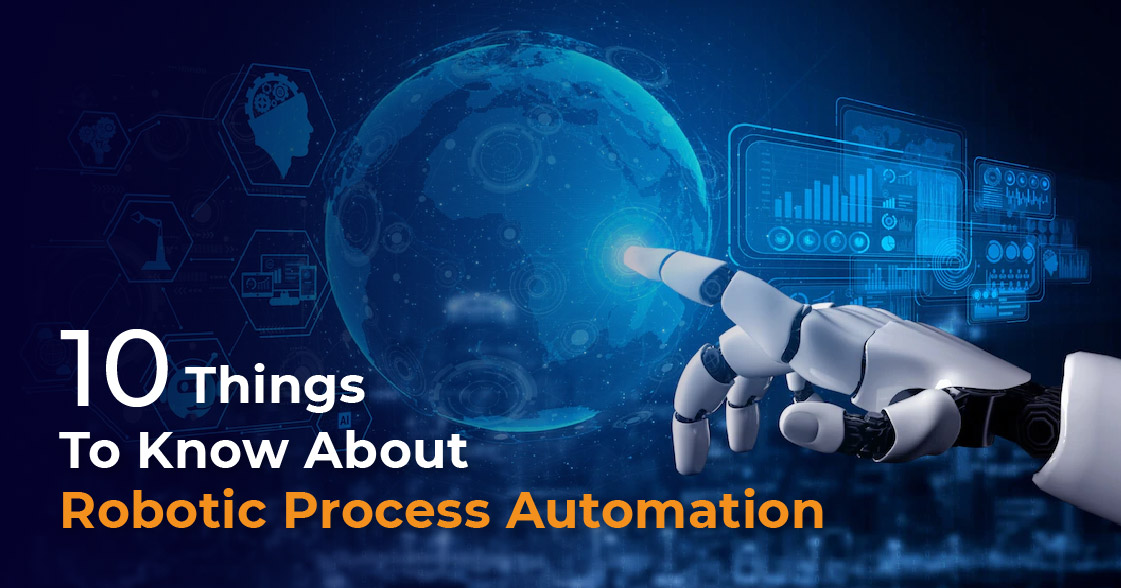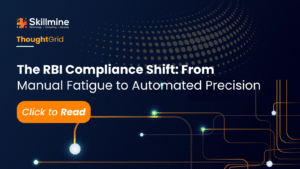McKinsey’s 2020 global survey of business leaders from a broad cross-section of industries found that 66% were piloting solutions to automate at least one business process, up from 57%, two years earlier. RPA, or Robotic Process Automation, is an automation system that uses robots or artificial intelligence (AI). RPA is seen as the future of automated testing, with a distinct methodology and numerous advantages. RPA offers a wide range of applications and is widely regarded as the future of test automation.
Robotic process automation software enhances operational efficiency, rendering organizations more profitable, adaptable, and agile. Simultaneously, it elevates employee satisfaction, engagement, and productivity by eliminating routine tasks from their daily responsibilities.
Robotic Process Automation is seamlessly integrated and swiftly deployed, expediting the digital transformation. Particularly well-suited for automating workflows entangled with legacy systems devoid of APIs, virtual desktop infrastructures (VDIs), or database access, RPA serves as an ideal solution.
Why is RPA transformative?
What makes RPA transformative is its ability to revolutionize how tasks are accomplished globally. Robotic Process Automation tools shift the paradigm by employing software robots to handle repetitive and less intricate tasks such as logging into applications, file management, data extraction, form completion, and routine analyses. Furthermore, advanced robots exhibit cognitive capabilities, such as text interpretation, engaging in conversations, deciphering unstructured data, and utilizing sophisticated machine learning models for intricate decision-making.
By entrusting robots with these labour-intensive, high-volume responsibilities, human resources can concentrate on their strengths and preferences: innovation, collaboration, creativity, and customer interaction. This dual benefit extends to enterprises, yielding heightened productivity, efficiency, and resilience. The transformative impact of RPA is evident in its capacity to redefine the narrative of work, demonstrating a profound shift in how tasks are executed and how human potential is maximized.
Presently, RPA is spearheading the attainment of enhanced efficiencies and relieving individuals from monotonous tasks across a wide array of industries and operational domains. Enterprises spanning from financial services to healthcare, manufacturing, the public sector, retail, and beyond have integrated RPA into diverse areas, including finance, compliance, legal, customer service, operations, and IT, to name a few.
Additionally, there is a growing trend towards applying RPA to cognitive processes demanding advanced AI skills. As a result, RPA has evolved into a transformative force that can revolutionise many industries and functions.
The following are ten facts concerning robotic process automation that you should be aware of.
RPA is an automation software:
Robotic Process Automation is a technology adaption based on a unique input to simplify daily operations and lower costs. Almost every organization relies on rule-based functions that can be automated with RPA. RPA allows repetitive or mundane tasks that would otherwise consume the time of business owners or consumers to be completed by customized software.
RPA technologies ( rpa software) comprehend and interpret data to be used or applied in new ways. RPA is a kind of hybrid between machine learning and full-fledged intelligent automation. RPA, in the end, manipulates data and triggers responses within digital systems, saving businesses a significant amount of time and labor.
CASE STUDY
The issue: A major manufacturer struggled to process hundreds of invoices from several vendors. The format of these scanned/digital invoices differed widely amongst vendors; more than four full-time employees were manually transcribing data from these invoices, which caused severe delays in processing. Due to many hierarchical approvals, the end-to-end procedure was further delayed.
The solution: Smart bots were used to automate time-consuming and laborious processes in the invoice processing process. The smart bots retrieved the data from various semi-structured and unstructured scanned and image-based documents, displayed it to users through an intuitive interface, and fed it. This system considerably sped up invoice approvals and could be scaled up to handle a growing quantity of invoices.
Importance of RPA:
Robotic Process Automation (RPA) uses bots to perform repetitive and tedious work in place of humans. RPA provides better efficiency, accuracy, and a higher return on investment. It also frees up human resources to be employed for more productive and better tasks. RPA is a highly tailored piece of software, often known as a Software Robot or a BOT, that performs a range of activities when deployed as part of the Digital Enterprise.
CASE STUDY
The issue: An upcoming bank faced difficulties with its business loan procedure due to internet connectivity challenges among remote employees. Branches with internet issues had longer turnaround times and had trouble collecting documents and getting permissions. Furthermore, the entire loan distribution procedure was carried out manually, resulting in errors and further delays and a detrimental influence on the customer experience.
The solution: A centralized automated loan distribution business process management system was integrated with the bank’s current business process management system. An interface for portable devices (mobile and tablet) that allowed distant bank employees to capture and synchronize customer data and important documents while offline was also built to resolve the issue.
The most popular RPA tools:
| Keysight’s Eggplant | Blue Prism | Uipath | Automation Anywhere | Pega | |
| Best suited for Industry type | Automotive, Aerospace & Defense, Financial Services, etc. | Core RPA Capabilities | Core RPA Capabilities | Core RPA Capabilities | BPM |
| Platform independence | Can test on any device, OS, or browser at any layer. | Supports any platform. | Yes. Supports Citrix. | Yes. On-premise and in the cloud. | Desktop Servers |
| Scalability | Extensible & can meet new challenges. | — | Can handle any process, in any number irrespective of its complexity | Yes. Scalable. | Scalable to Enterprise level. |
| OS Support | Windows, Mac, and Linux. | Windows Mac Web-based |
Windows Mac Web-based |
Windows Mac Web-based |
Windows Linux Mac Web-based |
| Industry size | Small to large | Medium Large |
Small Medium Large |
Medium Large |
Medium Large |
The benefits of RPA:
Here are a few benefits of RPA:
Cost-Effective
It’s been predicted that using robotics can save you up to 50% on operational expenditures. Having robots take over some of the labor-intensive tasks that humans do could benefit the company. Automation can help you recover the investment in a short period.
Consistency
Robotics is a non-invasive, safe technology that does not interfere with the natural systems and ensures perfect consistency in executing tasks every time.
Improved Analytics
Having access to error-free, correct data from various sources would increase the process’s analytics quality. This results in better decision-making and, as a result, better process execution.
Increased Customer Satisfaction
Customer satisfaction rises due to higher work quality, accuracy, and improved customer/client contact. This adds to the company’s goodwill.
Versatility
RPA’s versatility allows it to work across industries and handle various jobs. Any rule-based, defined, and repeatable process is a good candidate for automation.
Better IT Management and Support
RPA increases the service desk’s operational excellence and monitors the network. This allows businesses to absorb short-term spikes without hiring or educating more employees.
RPA will not replace the human workforce:
While it is true that some tasks previously performed by firm personnel will now be automated using RPA technology, this does not imply that human workers are no longer needed. Simply put, software robots cannot function without the assistance of humans, and they are currently incapable of performing more complex human high-level thinking processes. As a result, rather than remove or replace human personnel, the introduction of Robotic Process Automation technology will assist their performance.
RPA is not AI:
Artificial intelligence, deep learning, machine learning, and natural language processing are all terms that are frequently used to describe RPA. There are, however, distinctions. RPA and AI are two horizontal technologies with distinct purposes and user interfaces. RPA stands for Robotic Process Automation, and it is software that assists a human in automating a manual procedure. Unlike Machine Learning and Artificial Intelligence, which are data-driven, RPA is process-driven. Pre-built processes are subsequently automated for the human end-user through RPA. These processes are frequently repetitive, rule-based, and require the human end-user to connect with many line-of-business systems (such as SharePoint and Office 365). RPA can be thought of as the muscle, whereas ML and AI are the brains.
RPA is business-friendly:
RPA can be used by businesses in a variety of industries to automate routine processes that require little or no human intervention.
CASE STUDY
The issue: A specialist healthcare management organization sought to streamline its back-office activities to improve the patient experience. Patient data was scattered across disparate systems and faxed or scanned records were sometimes unstructured, confusing, and illegible. The manual extraction and review of patient data required more than ten personnel. This approach was prone to errors, resulting in delayed claims processing and payments.
The solution: RPA bots were deployed with cognitive capabilities to automate data extraction, data review, and claim submission operations, expediting the entire process from start to finish. The organization was able to cut the time it took to process a claim submission by 70%.
RPA is a flexible tool:
RPA tools require little or no coding, and you don’t have to change your underlying architecture because the bots use the same infrastructure and solutions that employees do. Business users drive RPA solutions in Healthcare. Traditional process automation techniques differ from RPA in the following ways:
Traditional automation techniques may necessitate the replacement of some or all of a company’s technical infrastructure. RPA bots use the graphical user interface and communicate with other systems, the same way that humans do.
RPA bots are adaptable enough to automate numerous applications’ procedures.
RPA bots are scalable and easier to upgrade than workflow solutions created for a single process because they are for repetitive, general operations like data input.
RPA is more than just automation:
RPA provides firms with unrivaled benefits. RPA is more than simply automation if we look at it closely. It solves a slew of typical issues for businesses of all sizes. Low process visibility, wasteful manual activities, and poor exception handling, to name a few, are all problems that RPA may help with.
CASE STUDY
The issue: A telecoms business needed to optimize its laborious, time-consuming, and error-prone site procurement and vendor payment procedures. Site allotment, purchase orders, job status updates, progress reports, and billing required users to manually generate and update information. SAP lacked a standard structure for storing such information, therefore both internal and external users had to traverse through multiple systems to get information.
The solution: To improve process visibility, an end-to-end procedure within the SAP system was standardized. RPA bots were also used to automate Outlook, Excel, and web operations, resulting in a 35 percent reduction in the average process handling time. The new approach also gave suppliers more visibility into order and payment statuses.
Conclusion: It’s similar to developing your virtual assistant when you actively integrate RPA into your team’s regular operations. Since your business gets to choose the applications and user interfaces your RPA will handle, you can develop a digital assistant that achieves your goals. It’s a smart technology with a lot of potential. RPA is geared up to open up many more doors in the future.
Looking for expert technology consulting services? Contact us today.
Frequently Asked Question
What is RPA and how does it work?
Organizations become more profitable, flexible, and responsive as a result of Robotic Process Automation. It also boosts employee satisfaction, engagement, and productivity by removing tedious chores from their daily routines.
What are the benefits of RPA?
The benefits of RPA for businesses include accelerated transformation, major cost savings, greater resilience, higher accuracy, improved compliance, increased productivity and customer satisfaction.





